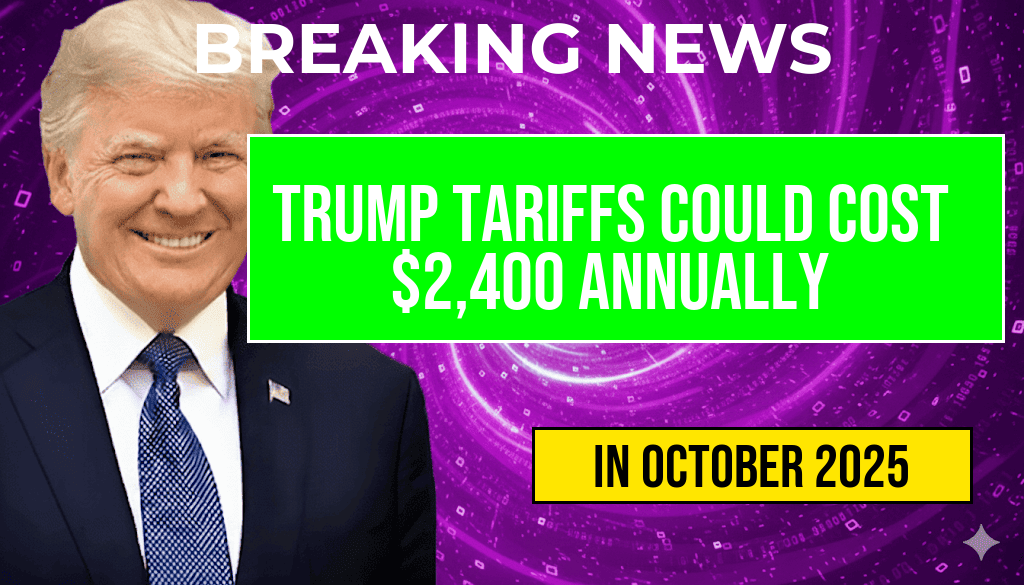Recent discussions surrounding former President Donald Trump’s trade policies suggest that tariffs implemented during his administration could be indirectly costing American families an estimated $2,400 annually. Dubbed the “Turbulence Tax” by critics, these tariffs aim to protect domestic industries but may instead be leading to higher prices for everyday goods and increased costs for businesses. As policymakers debate the future of trade strategies, households across the country are feeling the impact through elevated grocery bills, higher retail prices, and increased manufacturing costs. This analysis unpacks the details behind these tariffs, how they influence consumer expenses, and what this means for the national economy.
The Origins of the Tariffs and Their Intended Goals
Historical Context and Policy Rationale
During his tenure, President Trump adopted a protectionist approach, imposing tariffs on imports from several countries, notably China, Mexico, and the European Union. The primary goal was to bolster American manufacturing, safeguard jobs, and address trade imbalances. These tariffs targeted steel, aluminum, and various consumer goods, with the intention of pressuring trading partners into renegotiating trade deals.
According to the Wikipedia entry on trade wars, such tariffs are often used as leverage but can have unintended side effects, including retaliatory measures by trading partners. While some industries initially benefited from reduced foreign competition, the broader economic impact on consumers and supply chains became increasingly evident over time.
How Tariffs Translate into Higher Costs for Consumers
Pass-Through Effect on Prices
Tariffs increase the cost of imported goods, which often leads to higher retail prices. Retailers and manufacturers tend to pass these costs onto consumers to maintain profit margins. For example, tariffs on steel and aluminum have raised the prices of appliances, cars, and construction materials.
Research from the National Bureau of Economic Research indicates that tariff pass-through rates can vary, but in many cases, consumers bear a significant portion of the added costs. This effect accumulates across multiple sectors, culminating in an estimated annual increase of approximately $2,400 in household expenses for the average American family.
The Breakdown of the “Turbulence Tax”
| Category | Additional Cost |
|---|---|
| Grocery Items (imported food, beverages) | $800 |
| Automobiles and Auto Parts | $700 |
| Home Appliances and Electronics | $400 |
| Construction Materials (steel, aluminum) | $300 |
Note: These figures are estimates based on market analyses and consumer surveys conducted by economic research firms.
Economic Impacts Beyond Household Budgets
Effects on Business and Employment
While the tariffs aimed to protect certain American industries, many small and medium-sized businesses report increased costs and supply chain disruptions. Manufacturing companies face higher raw material prices, which can lead to reduced competitiveness or job cuts. According to data from the U.S. Bureau of Labor Statistics, some sectors experienced stagnation or decline in employment levels during tariff implementation periods.
Moreover, retaliatory tariffs from trading partners have further strained export markets, impacting farmers, tech companies, and service providers. This complex web of tariffs and countermeasures creates a form of economic turbulence, often referred to as the “Turbulence Tax,” that extends beyond individual households to influence national economic stability.
Policy Debates and Future Outlook
Calls for Reassessing Trade Strategies
As inflation continues to challenge the U.S. economy, policymakers are revisiting the efficacy of tariffs. Critics argue that the “Turbulence Tax” undermines consumer purchasing power and hampers economic growth, suggesting a shift toward more collaborative trade agreements. Meanwhile, supporters maintain that tariffs serve as necessary leverage to renegotiate fairer trade deals and protect strategic industries.
Recent proposals from Congress include measures to mitigate tariff impacts on low-income families and small businesses, emphasizing the importance of balancing protectionist policies with economic resilience. The debate remains active as the Biden administration considers whether to maintain, modify, or lift certain tariffs established during the previous administration.
Implications for American Families
For the average household, the “Turbulence Tax” manifests as an invisible but tangible pressure on the family budget. With grocery costs rising, car prices climbing, and home improvement expenses increasing, many families find themselves allocating more income to essentials. This financial strain complicates efforts to save, invest, or manage debt, especially amid broader economic uncertainties.
Understanding the roots and repercussions of these tariffs underscores the importance of informed policy decisions that weigh national economic goals against the direct impact on everyday Americans. As the debate continues, households are encouraged to monitor price trends and consider strategic adjustments in their budgets to navigate the ongoing turbulence.
For more on the economic effects of tariffs and trade policies, visit Forbes and Wikipedia.
Frequently Asked Questions
Question
What is the “Turbulence Tax” mentioned in the article?
Answer
The “Turbulence Tax” refers to the additional costs families may face due to Trump tariffs, which are expected to add approximately $2,400 annually to the family budget.
Question
How do tariffs impact the average American family’s expenses?
Answer
Tariffs increase the cost of imported goods, leading to higher prices for everyday items, which can cumulatively add up to about $2,400 per year for the typical family.
Question
Which products are most affected by these tariffs and contribute to the increased family costs?
Answer
Commonly affected products include electronics, clothing, and household goods. These tariffs raise prices on imported items, directly impacting household expenses.
Question
Are there any long-term economic effects of the “Turbulence Tax” for families?
Answer
Yes, the increased costs may lead to reduced purchasing power and could influence consumer spending, potentially affecting the broader economy over time.
Question
What can families do to mitigate the financial impact of the “Turbulence Tax”?
Answer
Families can consider budget adjustments, seeking alternative suppliers, or purchasing domestically to reduce the impact of tariffs and manage their expenses more effectively.






